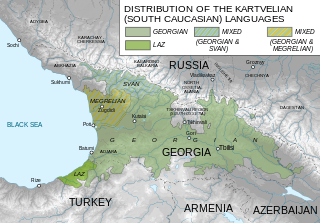Mamia II Dadiani (Georgian :მამია II დადიანი; died 1414) was a member of the House of Dadiani and eristavi ("duke") of Odishi, latter-day Mingrelia, in western Georgia from 1396 until his death.

Georgian is a Kartvelian language spoken by Georgians. It is the official language of Georgia. Georgian is written in its own writing system, the Georgian script. Georgian is the literary language for all regional subgroups of Georgians, including those who speak other Kartvelian languages: Svans, Mingrelians and the Laz.

The House of Dadiani was a Georgian family of nobles, dukes and princes, and a ruling dynasty of the western Georgian province of Samegrelo (Mingrelia) or Odishi.

Eristavi was a Georgian feudal office, roughly equivalent to the Byzantine strategos and normally translated into English as "duke". In the Georgian aristocratic hierarchy, it was the title of the third rank of prince and governor of a large province. Holders of the title were ex-officio commanders of a military 'banner', wore a distinctive dress, ring, belt and spear and rode a particular breed of horse.
Mamia was the son of Vameq I Dadiani, eristavi of Odishi, on whose death he succeeded in 1396. During his tenure, the Kingdom of Georgia was subjected to repeated attacks by the Turco-Mongol emir Timur, which devastated the country and shattered its unity. The western Georgian provinces were claimed by scions of the former kings of Imereti, but their attempts to bend the Dadiani into submission went in vain. Mamia continued his predecessors' efforts to aggrandize the duchy of Odishi. In 1414, he went to war against the Abkhazians, but was killed in battle. [1] [2]
Vameq I Dadiani was a member of the House of Dadiani and eristavi ("duke") of Odishi in western Georgia from 1384 until his death.

The Kingdom of Georgia, also known as the Georgian Empire, was a medieval Eurasian monarchy which emerged circa 1008 AD. It reached its Golden Age of political and economic strength during the reign of King David IV and Queen Tamar the Great from 11th to 13th centuries. Georgia became one of the pre-eminent nations of the Christian East, her pan-Caucasian empire stretching, at its largest extent, from Eastern Europe and the North Caucasus to the northern portion of Iran and Anatolia, while also maintaining religious possessions abroad, such as the Monastery of the Cross in Jerusalem and the Monastery of Iviron in Greece. It was the principal historical precursor of present-day Georgia.

Georgia, a Christian kingdom in the Caucasus, was subjected, between 1386 and 1403, to several disastrous invasions by the armies of Turco-Mongol conqueror Timur, whose vast empire stretched, at its greatest extent, from Central Asia into Anatolia. These conflicts were intimately linked with the wars between Timur (Tamerlane) and Tokhtamysh, the last khan of the Golden Horde and Timur’s major rival for control over the Islamic world. Timur officially proclaimed his invasions to be jihad against the region's non-Muslims. Although he was able to invade parts of Georgia, he was never able to make the country Muslim and even recognized Georgia to be a Christian state.
Mamia had two sons, Liparit I and Vameq II, both the future eristavi of Odishi. [3] If Tedo Zhordania's identification, in 1902, of Mamia II with the eristavt-eristavi ("duke of dukes") and mandaturt-ukhutsesi ("Lord High Steward") Mamia Dadiani, mentioned in a Georgian inscription on the omophorion from the Mokvi Cathedral is correct, then his wife was called Elene. Mamia and his wife Ekaterine, formerly called Elene, are also mentioned in a memorial side-note in the 13th-century Gospel from Vardzia and, probably, also in a similar text in the 11th-century Gospel from Urbnisi, in which the unnamed Dadiani's wife Ekaterine, formerly Elene, is referred to as "a daughter of the king". The woman's double-name suggests her becoming a nun. Zhordania's hypothesis was challenged, in 2001, by the historian Bezhan Khorava, who identified the Mamia of these texts as Mamia III Dadiani, who died in 1533. [4]
Liparit I Dadiani was a member of the House of Dadiani and eristavi ("duke") of Odishi, latter-day Mingrelia, in western Georgia from 1414 until his death. Under his rule, Mingrelia became largely independent from the disintegrating Kingdom of Georgia in the 1460s.
Vameq II Dadiani was a member of the House of Dadiani and eristavi ("duke") of Odishi (Mingrelia) in western Georgia from 1474 until his death.

Tedo Zhordania was a Georgian historian, philologist, and educator.

